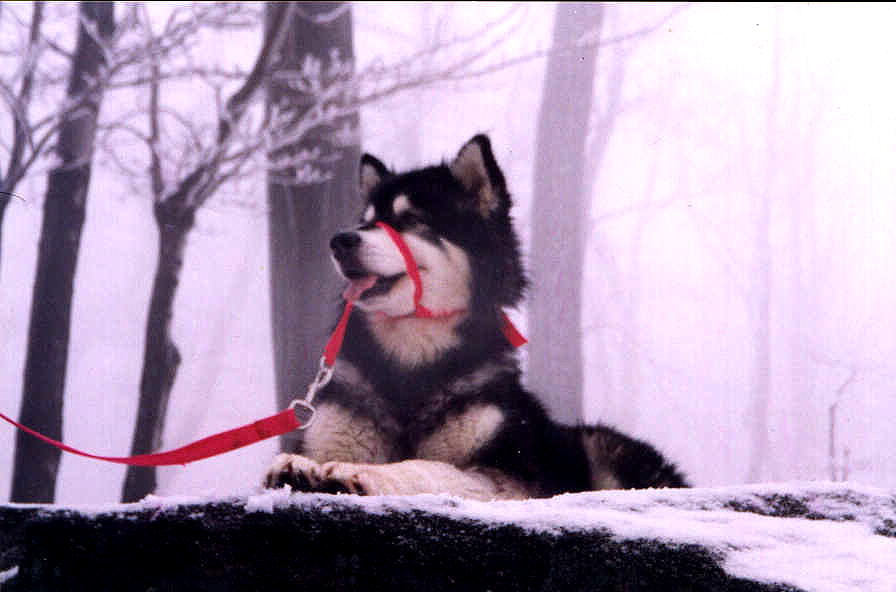
|
The heavy-freighting dog of the Inuit people on the shores of Kotzebue Sound, the Alaskan Malamute excels as an adaptable, intelligent canine companion. A heavy boned dog with a bulky muzzle, a broad head, wide-set ears, and a thickly-furred carried plume-like over the back, the Malamute is one of the most beautiful dogs on earth and, pound for pound, almost certainly the strongest. The average weight for males is 85 pounds, for females 75 pounds. Many Malamutes, including show dogs, are larger or smaller than average, and bigger is not necessarily better. Most Malamutes are gray with white trim or black and white, but coats of silver, sable, and red sometimes occur. Patterns of facial markings range from the all white "open face" to the "full mask" (combination of a black cap on the head, goggles around the eyes, and a bar down the muzzle). All Malamutes have brown eyes. Malamutes can bark, but they seldom do. The characteristic vocalization is a long series of woo-woo, but Malamutes also produce yips, growls, rumbles, and an immense variety of whirrs and other sounds not readily translated into English. Some Malamutes never howl. On the other hand, others will sound a spine-tingling reply to every passing siren. The breed is blessed with a sunny disposition. Happiest when treated as an intelligent partner, the Malamute is highly cooperative but never slavish or fawning. The Alaskan Malamute works and lives with you, not for you. Sometimes aggressive toward other dogs, especially those of the same sex, the typical Malamute is outrageously friendly to human beings. As the dogs of a peaceful, nomadic people, Malamutes do not guard property and virtually always extend a tail-wagging, face-licking welcome to strangers. These dogs develop deep, complex attachments to their owners, but are not one person dogs. Adult rescue Malamutes readily bond with their adoptive owners. The versatile malamute is happy to pull a sled, but is equally glad to accompany the backpacker, runner, casual walker, or TV watcher. Malamutes take an alert interest in their surroundings and are fascinating company. As a competitive Obedience dog, the Malamute is more legendary for crowd-pleasing antics than for good scores. The breed is, however, tremendous fun to train, if not always a joy to show in the Obedience ring. Superb natural predators, Malamutes must NEVER be allowed to run loose. Some Malamutes will raid trash cans and steal food inside the house. Most will chase cats. When challenged by other dogs, Malamutes do not back down. Anyone unprepared to deal firmly and calmly with a notable wild streak should not own an Alaskan Malamute. The prospective adopter who has never before owned any dog should consider a sedate older Malamute instead of a spunky young dog, as should anyone without the physical strength to handle a vigorous youngster. Fortunately, the Alaskan Malamute has a life-span of about 12 to 14 years. Thus, 5-year-old Malamute has, on the average, more years ahead of him than does a 5-day-old Irish Wolfhound. An Arctic dog, the Malamute may live outdoors in a sturdy kennel, but Malamutes also make splendid, companionable, almost odorless house dogs. Under no circumstances should a Malamute be kept on a chain, tie-out, or trolley. The indoor dog requires daily exercise on a leash or in a completely enclosed area such as a tennis court or fenced yard; the outdoor dog has an equally strong need for daily companionship and affection. The breed's double coat consists of a short, dense undercoat and outer coat of course guard hair. Malamutes shed profusely about twice a year. Except for those times, they require little grooming. Even a carefully groomed Malamute that is not actively shedding will nonetheless deposit some fur on carpets and automobiles. This is not the breed for the fastidiously house-proud or car-proud. |
If you have any questions about this page, or you would like to contact GAMR. You can contact Meg Staton.